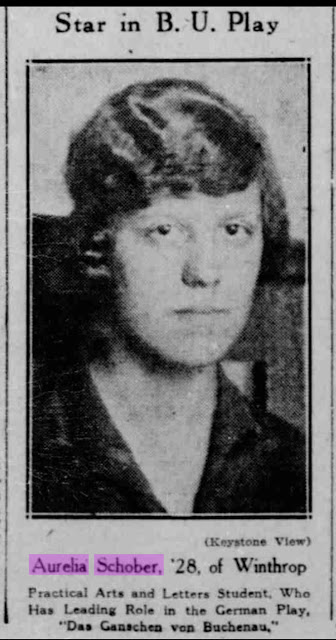Aurelia Schober's college classmates read, sort of sub rosa, the pop-psychology book The Nervous Housewife (1920) by neurologist/psychiatrist Abraham Myerson. He wrote:
One of the commonest and saddest transformations is the change of the gay, laughing girl, radiant with love and all aglow with the thought of union with her man, into the housewife of a decade -- complaining, fatigued, and disillusioned.
This was an open secret, but no one had ever put it quite that way before. I thought of Aurelia Schober, her college class's valedictorian, yearbook editor, German-language actress, voted by her peers "Most Studious," with a dashing Austrian boyfriend who was one of the century's greatest engineers, and in her sophomore year her headshot was published in The Boston Transcript:
 |
Aurelia, 19, in The Boston Transcript, 12 January 1926.
|
Much
of Aurelia's creativity and spunk got shell-shocked and died during an almost-nine-year marriage t
o human land mine Otto Plath, a behavioral scientist, at home a thrower of tantrums and a monocrat. The lasting effect on Aurelia was
perpetual anxiety. I believe that from her marriage and husband's needless death Aurelia had PTSD. The day after his death she signed a contract drawn up by her eight-year-old daughter never to marry again. And never did.
Then Aurelia had to support her children on a single woman's salary. Good thing she had prepared herself with
a master's degree and let her parents do live-in childcare. From their births Aurelia supported her children's education and growth in every possible way, was positive and honest with them: Aurelia was a talented mother.
Aurelia
Plath couldn't become a writer but seems to have used a surviving part of her dramatic talent and resonant voice to read aloud to
family and friends Sylvia's and Warren's letters from college. He
r children knew their letters were shared, and wrote accordingly.
Abraham Myerson (1881-1948), who thought socio-cultural pressures triggered addictions and mental illness, published other books for laymen such as
The Foundation of Personality, and one of his dozens of papers appeared in
The American Journal of Insanity, later renamed and still known as
The American Journal of Psychiatry.
